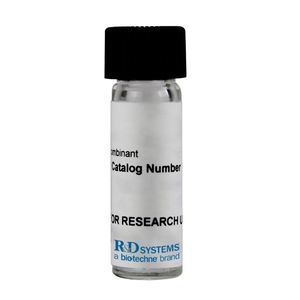
Cardiac troponin I reagent 612-CD seriesbovine serum albumincytokinefor research
Add to favorites
Compare this product
Characteristics
- Type
- bovine serum albumin, cytokine
- Applications
- for research, tissue
- Tested parameter
- cardiac troponin I
- Micro-organism
- CF
- Storage temperature
Max.: -20 °C
(-4 °F)Min.: -70 °C
(-94 °F)- Purity
95 %
Description
CF stands for Carrier Free (CF). We typically add Bovine Serum Albumin (BSA) as a carrier protein to our recombinant proteins. Adding a carrier protein enhances protein stability, increases shelf-life, and allows the recombinant protein to be stored at a more dilute concentration. The carrier free version does not contain BSA.
What formulation is right for me?
In general, we advise purchasing the recombinant protein with BSA for use in cell or tissue culture, or as an ELISA standard. In contrast, the carrier free protein is recommended for applications, in which the presence of BSA could interfere.
Endotoxin Level<0.01 EU per 1 μg of the protein by the LAL method.
Activity - Measured in a cell proliferation assay using TF‑1 human erythroleukemic cells.
Kitamura, T. et al. (1989) J. Cell Physiol. 140:323. The ED50 for this effect is 0.25‑1.25 ng/mL.
Source - E. coli-derived human Cardiotrophin-1/CT-1 protein
Ser2-Ala201
N-terminal Sequence
Analysis - Ser2
Predicted Molecular Mass - 21 kDa
Cardiotrophin-1 (CT-1) is a member of the cytokine family which also includes IL-6, IL-11, leukemia inhibitory factor (LIF), oncostatin M (OSM), and ciliary neurotrophic factor (CNTF). It was originally isolated based on its ability to induce cardiac myocyte hypertrophy in vitro. CT-1 has since been shown to be a pleiotrophic cytokine with overlapping actions with other IL-6 family members on a variety of cell types. Human CT-1 encodes a 201 amino acid (aa) residue protein that lacks a hydrophobic signal peptide. The mechanism of CT-1 release from cells is currently not understood. Human and mouse CT-1 share 80% aa sequence identity and exhibit cross-species activity.
Catalogs
No catalogs are available for this product.
See all of R&D Systems‘s catalogsRelated Searches
- Assay kit
- Solution reagent kit
- Blood assay kit
- Serum assay kit
- Immunoassay assay kit
- Plasma assay kit
- Research reagent kit
- Protein reagent kit
- Diagnostic reagent kit
- Enzyme reagent kit
- Histology reagent kit
- Reagent medium reagent kit
- Immunology reagent
- Cytology reagent kit
- Antibody
- Buffer solution reagent kit
- ELISA assay kit
- Research assay kit
- Clinical reagent kit
- Virus reagent kit
*Prices are pre-tax. They exclude delivery charges and customs duties and do not include additional charges for installation or activation options. Prices are indicative only and may vary by country, with changes to the cost of raw materials and exchange rates.




